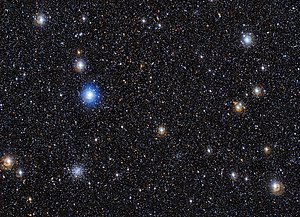
The gravitational binding energy of a system is the minimum energy which must be added to it in order for the system to cease being in a gravitationally bound state. A gravitationally bound system has a lower (i.e., more negative) gravitational potential energy than the sum of the energies of its parts when these are completely separated—this is what keeps the system aggregated in accordance with the minimum total potential energy principle.
The gravitational binding energy can be conceptually different within the theories of newtonian gravity and Albert Einstein's theory of gravity called General Relativity. In newtonian gravity, the binding energy can be considered to be the linear sum of the interactions between all pairs of microscopic components of the system, while in General Relativity, this is only approximately true if the gravitational fields are all weak. When stronger fields are present within a system, the binding energy is a nonlinear property of the entire system, and it cannot be conceptually attributed among the elements of the system. In this case the binding energy can be considered to be the (negative) difference between the ADM mass of the system, as it is manifest in its gravitational interaction with other distant systems, and the sum of the energies of all the atoms and other elementary particles of the system if disassembled.
For a spherical body of uniform density, the gravitational binding energy U is given in newtonian gravity by the formula[2][3] where G is the gravitational constant, M is the mass of the sphere, and R is its radius.
Assuming that the Earth is a sphere of uniform density (which it is not, but is close enough to get an order-of-magnitude estimate) with M = 5.97×1024 kg and r = 6.37×106 m, then U = 2.24×1032 J. This is roughly equal to one week of the Sun's total energy output. It is 37.5 MJ/kg, 60% of the absolute value of the potential energy per kilogram at the surface.
The actual depth-dependence of density, inferred from seismic travel times (see Adams–Williamson equation), is given in the Preliminary Reference Earth Model (PREM).[4] Using this, the real gravitational binding energy of Earth can be calculated numerically as U = 2.49×1032 J.
According to the virial theorem, the gravitational binding energy of a star is about two times its internal thermal energy in order for hydrostatic equilibrium to be maintained.[2] As the gas in a star becomes more relativistic, the gravitational binding energy required for hydrostatic equilibrium approaches zero and the star becomes unstable (highly sensitive to perturbations), which may lead to a supernova in the case of a high-mass star due to strong radiation pressure or to a black hole in the case of a neutron star.
- ^ "Spot the cluster". www.eso.org. Retrieved 31 July 2017.
- ^ a b Chandrasekhar, S. 1939, An Introduction to the Study of Stellar Structure (Chicago: U. of Chicago; reprinted in New York: Dover), section 9, eqs. 90–92, p. 51 (Dover edition)
- ^ Lang, K. R. 1980, Astrophysical Formulae (Berlin: Springer Verlag), p. 272
- ^ Dziewonski, A. M.; Anderson, D. L. (1981). "Preliminary Reference Earth Model". Physics of the Earth and Planetary Interiors. 25 (4): 297–356. Bibcode:1981PEPI...25..297D. doi:10.1016/0031-9201(81)90046-7.
